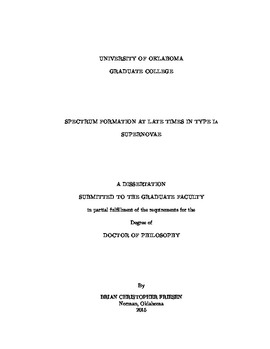| dc.description.abstract | I present a study of radiative transfer effects in type Ia supernovae ranging from 3-4 months to nearly 2 years post-maximum light. I explore several components of spectrum formation, beginning with a semi-analytic model which examines the behavior of line scattering in an optically thin medium, reminiscent of SN Ia ejecta at late times, and compare such behavior with the effects of line scattering at early times in SNe Ia, when the ejecta are optically thick. The model shows that line scattering produces spectral features similar to P Cygni profiles found near maximum light in SNe, but with subtle wavelength shifts which may lead to misidentified lines in observed spectra if these effects are not taken into account. Next, I present near-infrared synthetic spectra from numerical calculations with
the general-purpose radiative transfer code PHOENIX, and compare them to observations obtained of four normal type Ia supernovae several months post-maximum light, including the recent and nearby SN 2014J. Such comparisons reveal that, even this late in a supernova’s life, permitted lines of iron-peak elements comprise most of the near-infrared spectrum. In addition, an emission feature from [Ni II] near 2 μm indicates that electron capture during high-density nuclear burning likely takes place in a significant fraction of type Ia supernovae. Such high-density burning is difficult to obtain in explosions of sub-Chandrasekhar-mass progenitors,
e.g., white dwarf mergers. Finally I perform spectrum calculations at even later epochs, from 100 to 578 days after maximum light, and compare the results to the observed optical and ultraviolet spectra of the nearby SN 2011fe. I find that, contrary to much of the literature, our models fit SN 2011fe at day +100 without accounting for any forbidden atomic lines; the optical spectrum consists primarily of permitted Fe II and Ca II. Including forbidden lines and repeating the same calculation yields similar optical spectra, but with quite different atomic lines contributing to most of the features, leading to a curious degeneracy among interpretations of spectra at this epoch. At later epochs, forbidden emission from Fe II and Fe III form most of the optical spectrum, although the H & K doublet of Ca II continues to play a role in the emission near 4000 A. In the ultraviolet spectrum at day +360, the SED is optically thick, and most of the spectrum consists of permitted lines of various iron-peak species. These results show that the transition to the “nebular” phase in type Ia supernovae is more complicated
than frequently assumed in the literature, and is highly wavelength-dependent. | en_US |
